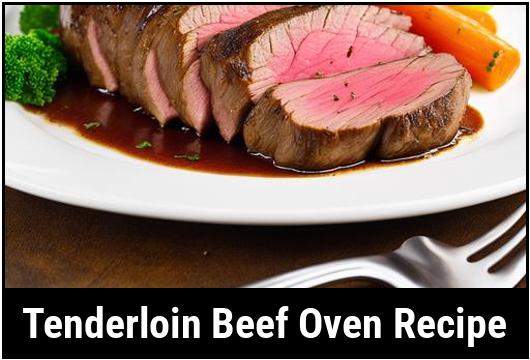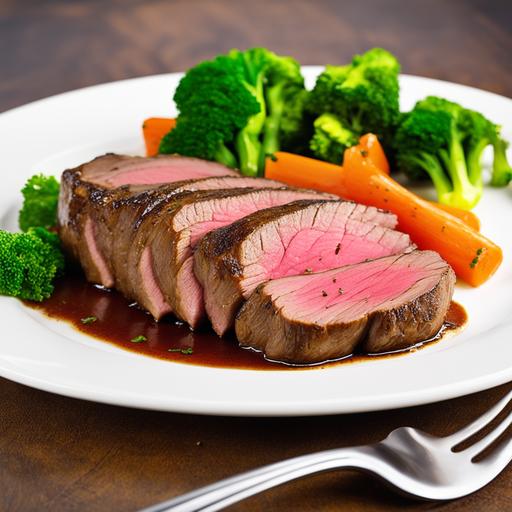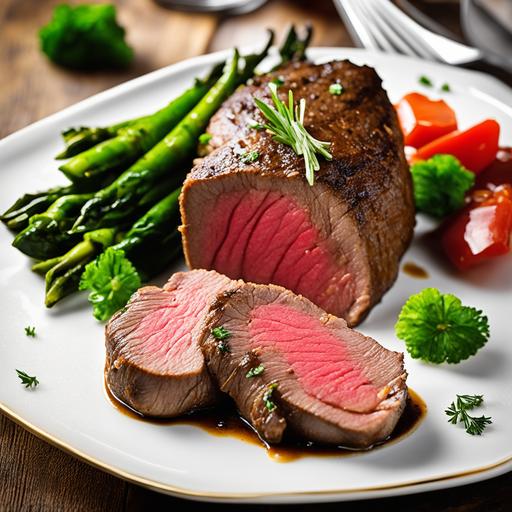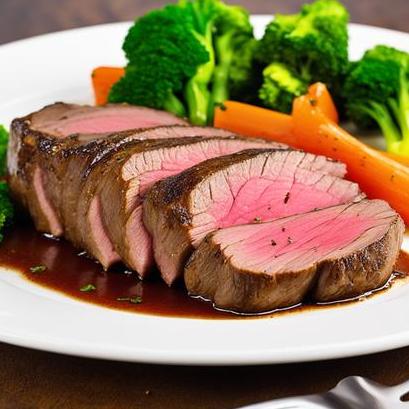
Tenderloin Beef Oven Recipe: A Comprehensive Guide
Tenderloin beef is renowned for its tender, succulent texture and rich flavor. Cooking tenderloin beef in an oven is a classic method that allows for precise temperature control, resulting in perfectly cooked meat every time. In this article, we will delve into the science behind cooking tenderloin beef in an oven, explore the selection of ingredients, discuss preparation techniques, and provide a detailed recipe for creating a mouthwatering tenderloin beef dish in your own kitchen.
Food Science Of Cooking Tenderloin Beef In An Oven
Cooking tenderloin beef in an oven involves a delicate balance of heat, time, and technique to achieve optimal results. The tenderloin is a muscle located along the backbone of the animal, known for its tenderness due to its minimal connective tissue. However, it is also relatively lean compared to other cuts, making it prone to drying out if overcooked.
When subjected to heat, the proteins in the beef undergo denaturation and coagulation, causing the muscle fibers to contract and expel moisture. This process is essential for developing flavor and texture but must be carefully controlled to prevent the meat from becoming tough or dry.
The oven provides a consistent and even heat source, allowing for gentle cooking that slowly raises the internal temperature of the meat without causing excessive moisture loss. By selecting the appropriate cooking temperature and timing, you can ensure that the tenderloin beef is cooked to perfection, with a juicy, melt-in-your-mouth consistency.
Choosing Ingredients
Selecting high-quality ingredients is key to creating a delicious tenderloin beef dish. When choosing a tenderloin, look for meat that is bright red in color with marbling throughout. Marbling refers to the intramuscular fat that runs through the meat, adding flavor and juiciness. Avoid cuts that are discolored or have excessive fat around the edges, as this can indicate poor quality or improper handling.
In addition to the beef itself, consider the seasonings and aromatics that will complement the natural flavor of the meat. Common herbs and spices used in tenderloin beef recipes include rosemary, thyme, garlic, and black pepper. Experiment with different combinations to find the flavor profile that best suits your taste preferences.
For added depth of flavor, consider marinating the tenderloin before cooking. A simple marinade of olive oil, soy sauce, garlic, and herbs can infuse the meat with flavor and help tenderize it further. Alternatively, you can dry-brine the beef by seasoning it generously with salt and allowing it to rest in the refrigerator for several hours before cooking. This method helps to draw out moisture from the surface of the meat, resulting in a crispy, caramelized crust when seared.
Preparing Ingredients

Proper preparation of the ingredients is essential for ensuring a successful tenderloin beef dish. Start by trimming any excess fat or silver skin from the surface of the tenderloin using a sharp knife. This not only improves the appearance of the meat but also allows for more even cooking.
Next, season the tenderloin generously with salt and pepper, ensuring that all sides are coated evenly. If using a marinade, pour it over the meat and massage it in gently to ensure that it is evenly distributed. Allow the meat to marinate for at least 30 minutes, or preferably overnight, to allow the flavors to penetrate the meat fully.
While the meat is marinating, prepare any additional ingredients or side dishes that will accompany the tenderloin. This could include roasted vegetables, mashed potatoes, or a flavorful sauce to drizzle over the meat.
Optimal Oven Cooking Temperature & Timing
Achieving the perfect level of doneness when cooking tenderloin beef in an oven requires careful attention to temperature and timing. For medium-rare beef, which is the most popular level of doneness for tenderloin, aim for an internal temperature of 130-135°F (54-57°C). This will result in meat that is pink and juicy with a slightly firm texture.
To achieve this level of doneness, preheat your oven to 425°F (218°C). Place the seasoned tenderloin on a roasting rack set inside a roasting pan to allow for air circulation around the meat. Roast the beef for approximately 20-25 minutes per pound, or until the desired internal temperature is reached. Use a meat thermometer inserted into the thickest part of the tenderloin to monitor the temperature throughout the cooking process.
Once the tenderloin reaches the desired temperature, remove it from the oven and tent it loosely with aluminum foil. Allow the meat to rest for 10-15 minutes before slicing to allow the juices to redistribute evenly throughout the meat.
Tenderloin Beef Oven Recipe
Ingredients
- 1 whole beef tenderloin (about 4-5 pounds)
- Salt and pepper, to taste
- 2 tablespoons olive oil
- 4 cloves garlic, minced
- 2 teaspoons fresh thyme leaves
Instructions
- Preheat your oven to 425°F (218°C).
- Trim any excess fat or silver skin from the surface of the tenderloin using a sharp knife.
- Season the tenderloin generously with salt and pepper on all sides.
- In a small bowl, combine the olive oil, minced garlic, and thyme leaves.
- Rub the garlic and thyme mixture all over the surface of the tenderloin, ensuring that it is evenly coated.
- Place the seasoned tenderloin on a roasting rack set inside a roasting pan.
- Roast the beef in the preheated oven for 20-25 minutes per pound, or until the internal temperature reaches 130-135°F (54-57°C) for medium-rare doneness.
- Once the tenderloin reaches the desired temperature, remove it from the oven and tent it loosely with aluminum foil.
- Allow the meat to rest for 10-15 minutes before slicing.
- Slice the tenderloin into thick slices and serve immediately with your favorite side dishes.
Cooking tenderloin beef in an oven is a straightforward yet rewarding process that yields tender, flavorful meat with minimal effort. By understanding the science behind the cooking process, selecting high-quality ingredients, and employing proper preparation techniques, you can create a restaurant-quality dish in the comfort of your own kitchen. Whether you’re cooking for a special occasion or simply craving a delicious meal, this tenderloin beef oven recipe is sure to impress even the most discerning palate.
Doneness Checks

Tenderloin beef, derived from the loin section of the cow, is prized for its unparalleled tenderness and mild flavor profile. It is often considered the epitome of luxury in the world of steaks. Cooking tenderloin beef in the oven offers a convenient and foolproof method to achieve perfect results every time.
Before diving into the cooking process, it’s essential to select high-quality tenderloin beef. Look for cuts that are well-marbled with fat, as this contributes to both flavor and tenderness. Additionally, ensure that the beef is properly trimmed of excess fat and silverskin for a more refined eating experience.
Achieving the perfect level of doneness is crucial when cooking tenderloin beef. Here are some methods to gauge the doneness of your steak:
1. Visual Inspection
- Rare: A rare steak will have a cool red center and soft texture. It should feel quite springy to the touch.
- Medium Rare: This is the most popular level of doneness for tenderloin beef. The center will be warm, reddish-pink, and slightly firm to the touch.
- Medium: A medium steak will have a warm pink center and a firmer texture compared to medium rare.
- Medium Well: At this stage, the center will be slightly pink with a hint of warmth. The steak will feel firm to the touch.
- Well Done: A well-done steak will have little to no pinkness in the center and will feel very firm to the touch.
2. Meat Thermometer
Using a meat thermometer is the most accurate way to determine the doneness of tenderloin beef. Insert the thermometer into the thickest part of the steak:
- Rare: 120°F to 125°F (49°C to 52°C)
- Medium Rare: 130°F to 135°F (54°C to 57°C)
- Medium: 140°F to 145°F (60°C to 63°C)
- Medium Well: 150°F to 155°F (66°C to 68°C)
- Well Done: 160°F and above (71°C and above)
3. Finger Test
- Rare: When pressed with your index finger, a rare steak will feel soft and squishy, similar to pressing the base of your thumb.
- Medium Rare: A medium-rare steak will feel slightly firmer than rare, similar to pressing the middle of your palm.
- Medium: This level of doneness will feel firm with a slight give, akin to pressing the base of your thumb.
- Medium Well: A medium-well steak will feel quite firm with only a slight give, resembling the firmness of the base of your thumb.
- Well Done: When pressed, a well-done steak will feel very firm, similar to pressing the tip of your nose.
Undercooking
Undercooking tenderloin beef can result in a steak that is overly chewy and lacks the desired tenderness. Here are some common reasons why tenderloin beef may be undercooked:
- Insufficient Cooking Time: Tenderloin beef requires precise cooking times to achieve the desired level of doneness. Underestimating the cooking time can result in an undercooked steak.
- Inadequate Oven Temperature: Ensure that your oven is preheated to the recommended temperature before placing the beef inside. A lower-than-expected oven temperature can prolong the cooking process, leading to undercooked meat.
- Thicker Cuts: Thicker cuts of tenderloin beef will naturally require longer cooking times to reach the desired doneness. Adjust your cooking time accordingly based on the thickness of the steak.
- Incorrect Placement in the Oven: Placing the beef too close to the top or bottom of the oven can affect the cooking process. Aim to position the steak in the center of the oven for even heat distribution.
If you find that your tenderloin beef is undercooked, you can salvage it by returning it to the oven and cooking it for additional time. Use a meat thermometer to monitor the internal temperature and ensure that it reaches the desired level of doneness.
Overcooking
Overcooking tenderloin beef can result in a dry, tough steak that lacks flavor. Here are some common reasons why tenderloin beef may be overcooked:
- Excessive Cooking Time: Cooking tenderloin beef for longer than necessary can lead to overcooking. It’s crucial to adhere to the recommended cooking times for each level of doneness.
- High Oven Temperature: Cooking the beef at too high a temperature can cause it to cook too quickly on the outside while remaining undercooked on the inside. Use a moderate oven temperature for more consistent results.
- Failure to Rest the Steak: Allowing the steak to rest after cooking is essential for redistributing the juices evenly throughout the meat. Skipping this step can result in a dry steak.
- Using an Improper Cooking Method: Different cooking methods require different techniques to achieve optimal results. Ensure that you’re following the appropriate instructions for cooking tenderloin beef in the oven.
If you find that your tenderloin beef is overcooked, there are a few strategies you can employ to mitigate the issue. Consider serving the steak with a flavorful sauce or garnish to add moisture and enhance the overall dining experience.
Troubleshooting

Encountering issues during the cooking process is not uncommon, but with a few troubleshooting techniques, you can overcome them effectively:
1. Uneven Cooking
- Solution: Rotate the beef halfway through the cooking process to ensure even heat distribution. Additionally, consider using a baking sheet with a wire rack to elevate the steak and promote airflow.
2. Burnt Exterior
- Solution: If the exterior of the beef becomes overly charred during cooking, loosely tent it with aluminum foil to prevent further browning. Reduce the oven temperature slightly to prevent burning.
3. Dry Texture
- Solution: To remedy a dry texture, consider serving the beef with a sauce or gravy to add moisture. Alternatively, thinly slice the steak and serve it with a drizzle of olive oil or melted butter.
4. Lack Of Flavor
- Solution: Enhance the flavor of the beef by marinating it before cooking or seasoning it generously with herbs and spices. Experiment with different seasoning blends to find your preferred flavor profile.
Recipe Variations
While the classic preparation of tenderloin beef in the oven is undeniably delicious, there are several recipe variations to explore:
1. Bacon-Wrapped Tenderloin
- Ingredients: Tenderloin beef, bacon slices, salt, pepper, garlic powder.
- Instructions: Wrap the tenderloin beef with bacon slices, securing them with toothpicks. Season with salt, pepper, and garlic powder before roasting in the oven until desired doneness is achieved.
2. Herb-Crusted Tenderloin
- Ingredients: Tenderloin beef, fresh herbs (such as rosemary, thyme, and parsley), olive oil, salt, pepper.
- Instructions: Coat the tenderloin beef with a mixture of finely chopped herbs, olive oil, salt, and pepper. Roast in the oven until the herb crust is golden brown and the beef is cooked to your liking.
3. Red Wine Reduction
- Ingredients: Tenderloin beef, red wine, beef broth, shallots, garlic, butter.
- Instructions: Prepare a red wine reduction sauce by simmering red wine, beef broth, shallots, and garlic until reduced by half. Finish the sauce with a knob of butter and serve it alongside the roasted tenderloin beef.
Cooking tenderloin beef in the oven is a culinary art that rewards patience and precision. By understanding the various doneness checks, troubleshooting common issues, and exploring recipe variations, you can elevate your cooking skills and create memorable dining experiences. Whether you prefer a classic preparation or wish to experiment with innovative flavors, mastering the art of cooking tenderloin beef in the oven will undoubtedly impress your guests and delight your taste buds.
Flavour Enhancement Tips
Tenderloin beef, known for its tender texture and succulent flavor, is a prized cut of meat cherished by meat lovers worldwide. Cooking tenderloin beef in the oven allows for a slow, even cook that maximizes its natural tenderness and juiciness.
-
Marinade Magic: Before cooking, marinating the tenderloin beef can infuse it with layers of flavor. Choose a marinade that complements the natural richness of the beef, such as a mixture of olive oil, garlic, fresh herbs like rosemary and thyme, and a splash of balsamic vinegar for depth.
-
Seasoning Sensation: Don’t skimp on seasoning. A generous sprinkle of salt and pepper on all sides of the tenderloin beef helps to enhance its natural flavors. For an extra kick, consider adding spices like smoked paprika, cumin, or chili powder to create a tantalizing crust.
-
Herbaceous Rub: Create a herb rub using a combination of finely chopped herbs like parsley, sage, and oregano mixed with minced garlic and olive oil. Rub this mixture all over the beef to impart a fragrant herbal essence.
-
Citrus Zest: Adding citrus zest, such as lemon or orange, to the marinade or rub can provide a refreshing contrast to the richness of the beef, brightening up the flavors and adding a zesty twist.
-
Wine Infusion: For an extra layer of complexity, consider incorporating red wine into your marinade or deglazing the pan with wine while cooking. The wine adds depth of flavor and helps to tenderize the meat further.
Texture Enhancement Tips

-
Temperature Control: Bringing the beef to room temperature before cooking ensures even cooking throughout. Remove the tenderloin beef from the refrigerator at least 30 minutes before cooking to allow it to temper.
-
Patience is Key: Avoid overcooking the tenderloin beef, as it can quickly become dry and tough. Aim for a medium-rare to medium doneness for the perfect balance of tenderness and juiciness.
-
Resting Period: After removing the beef from the oven, allow it to rest for 10-15 minutes before slicing. This allows the juices to redistribute, resulting in a more succulent and flavorful final dish.
-
Searing Step: Searing the beef before transferring it to the oven creates a caramelized crust on the exterior while sealing in the juices. Heat a skillet over high heat and sear the beef on all sides until golden brown before placing it in the oven.
-
Basting Technique: During the cooking process, baste the beef with melted butter or olive oil at regular intervals to keep it moist and flavorful. This additional moisture helps prevent the beef from drying out, resulting in a tender and juicy texture.
Cooking At Different Temperatures
-
High Temperature Roast: Preheat the oven to 450°F (232°C) for a high-temperature roast. This method quickly sears the exterior of the beef, creating a caramelized crust while maintaining a juicy interior. Cook the tenderloin beef for 15-20 minutes per pound for medium-rare doneness.
-
Low Temperature Roast: For a slow and gentle cook, preheat the oven to 275°F (135°C). This low and slow method allows the beef to cook evenly without drying out, resulting in a melt-in-your-mouth texture. Cook the tenderloin beef for 25-30 minutes per pound for medium-rare doneness.
-
Reverse Sear Technique: Start by cooking the beef at a low temperature (275°F) until it reaches an internal temperature of about 115°F (46°C). Then, increase the oven temperature to 450°F and sear the beef for a few minutes on each side until golden brown. This method ensures a perfectly cooked interior with a flavorful crust.
Cooking Tips
-
Proper Trussing: Trussing the tenderloin beef with butcher’s twine helps maintain its shape during cooking and ensures even cooking throughout. Tie the twine at regular intervals along the length of the beef to secure it firmly.
-
Use a Meat Thermometer: Invest in a reliable meat thermometer to accurately gauge the doneness of the beef. Insert the thermometer into the thickest part of the beef, away from any bones, to ensure an accurate reading.
-
Oven Positioning: For even cooking, position the oven rack in the center of the oven. This allows the heat to circulate evenly around the beef, ensuring consistent results.
-
Pan Selection: Choose a heavy-bottomed roasting pan or cast iron skillet for optimal heat distribution. Avoid using lightweight pans, as they may result in uneven cooking and hot spots.
-
Resting Time: Resist the temptation to slice the beef immediately after removing it from the oven. Allow it to rest on a cutting board tented with foil for 10-15 minutes to allow the juices to redistribute evenly.
Serving Suggestions
-
Classic Pairings: Serve the tenderloin beef with classic accompaniments such as creamy mashed potatoes, roasted vegetables, and a rich red wine jus. The creamy texture of the mashed potatoes and the savory flavors of the vegetables complement the beef beautifully.
-
Fresh Herb Garnish: Sprinkle freshly chopped herbs like parsley or chives over the sliced beef before serving for a pop of color and freshness. The bright herbal notes enhance the overall presentation and add a layer of complexity to the dish.
-
Crunchy Contrast: Add a textural contrast by serving the beef with a side of crispy onion rings or shoestring fries. The crunchy exterior of the onion rings complements the tender beef, creating a satisfying contrast in every bite.
-
Sauce Selection: Elevate the dish with a flavorful sauce such as creamy peppercorn sauce or a tangy horseradish cream. Drizzle the sauce over the sliced beef or serve it on the side for dipping.
-
Wine Pairing: Pair the tenderloin beef with a full-bodied red wine such as Cabernet Sauvignon or Merlot. The bold flavors of the wine complement the richness of the beef, creating a harmonious pairing that enhances the dining experience.
Conclusion
Mastering the art of cooking tenderloin beef in the oven requires attention to detail and a willingness to experiment with flavors and techniques. By following the tips and techniques outlined in this guide, you can create a mouthwatering tenderloin beef dish that is sure to impress family and friends alike. From enhancing flavors with marinades and rubs to perfecting textures through proper cooking methods, each step plays a crucial role in creating a culinary masterpiece. So fire up your oven, sharpen your knives, and prepare to embark on a culinary journey that celebrates the exquisite flavors of tenderloin beef.
FAQS
What Type Of Cut Is Best For A Tenderloin Beef Oven Recipe?
The most ideal cut for a tenderloin beef oven recipe is a beef tenderloin, also known as filet mignon. It is a lean and tender cut of beef that is perfect for cooking in the oven.
Do I Need To Marinate The Beef Before Cooking It In The Oven?
No, marinating is not necessary for a tenderloin beef oven recipe. The beef is naturally tender and does not require any additional tenderizing.
How Long Does It Take To Cook A Tenderloin Beef In The Oven?
The cooking time for a tenderloin beef in the oven varies depending on the size and thickness of the meat. Generally, a 2-3 pound tenderloin will take about 25-30 minutes to cook at 425 degrees Fahrenheit.
Should I Cover The Beef With Foil While It Cooks In The Oven?
It is not necessary to cover the beef with foil while it cooks in the oven. However, you can use foil to tent the beef after it is cooked to allow it to rest and keep it warm until ready to serve.
What Is The Best Temperature To Cook Tenderloin Beef In The Oven?
The recommended temperature for cooking tenderloin beef in the oven is 425 degrees Fahrenheit. This high heat allows for a quick and even cooking of the beef, resulting in a juicy and flavorful dish.


